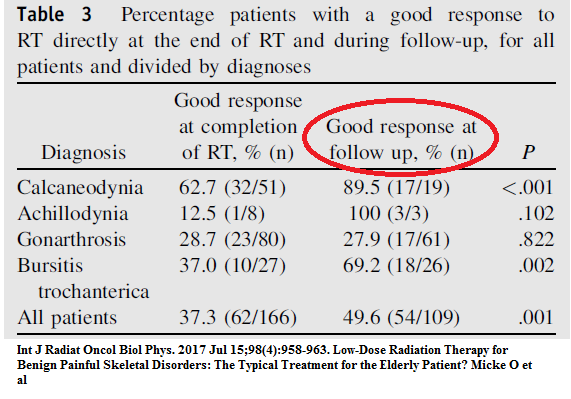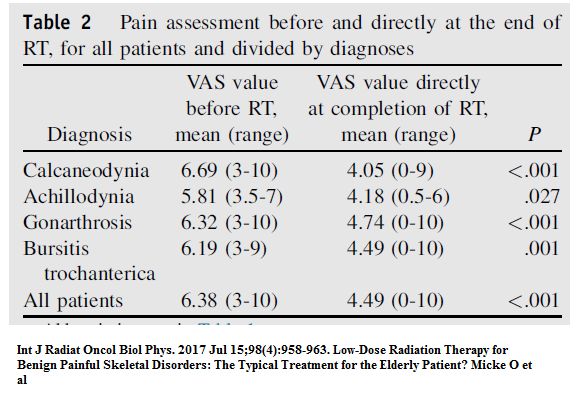Low dose Radiotherapy over age 70 has minimal risks but can often drop pain by 1.9/10 in following issues – sore heel and achilles pains, knee pains, and trochanteric bursitis.
Int J Radiat Oncol Biol Phys. 2017 Jul 15;98(4):958-963. doi:
10.1016/j.ijrobp.2016.12.012.
Low-Dose Radiation Therapy for Benign Painful Skeletal Disorders: The Typical Treatment for the Elderly Patient?
Micke O et al.
https://www.ncbi.nlm.nih.gov/pubmed/28258900
- 65 years or more has increased from 16.6% to 20.7%,
- average age rose from 41 to 43 years
- “group aged >70 years, and the group aged >80 years will quadruple
over the next 20 to 40 years.” - painful skeletal disorders more difficult to treat over 70 as tolerance to both NSAIDs and opioids is low.
- German study – makes note that ” Nonmalignant indications for RT [radiotherapy] constitute approximately 10% to 30% of all patient treatments in most academic, public, and private RT facilities in Germany.”
- “Radiation therapy was performed with both linear accelerator and orthovoltage conditions. Single doses of 0.5 to 1.0 Gy and a total dose of 6.0 Gy per series were used.”
Treated:
- calcaneodynia (sore heels)
- achillodynia (sore achilles)
- painful gonarthrosis (sore knee)
- painful bursitis trochanterica (lateral hip bursitis)
Reason use in elderly acceptable:
“reported lifetime risk of cancer induction is approximately 0.2% with low-dose joint irradiation, the main risk being induction of leukemia. However, the risk decreases with increasing age (8, 31, 32). Hence, in contrast to younger patients, low-dose RT in elderly patients can be used as a first treatment option too, because the carcinogenic
risk can be nearly neglected. Clearly, most radiation-induced malignancies have a latency of 15 to 30 years to develop, which will not play a role compared with the life expectancy
of the population.”
Results:
- 33 (30.3%) free of pain,
- 21 (19.3%) marked improvement
- 18 (16.5%) some improvement,
- 37 (33.9%) no change.
Though results from knee werer often seen right away, most other conditions were not better until some time later:
 Comment – Heel and achilles seem to respond very well. Knee pain will drop pain by 1.58/10 (6.32 to 4.74). Given that 4 is a level you can ignore, this is still a relevant change. Combine with acetaminophin and maybe low dose opioids this would be livable. Now to just convince radiotherapists…
Comment – Heel and achilles seem to respond very well. Knee pain will drop pain by 1.58/10 (6.32 to 4.74). Given that 4 is a level you can ignore, this is still a relevant change. Combine with acetaminophin and maybe low dose opioids this would be livable. Now to just convince radiotherapists…
Addendum:
More interest has been shown in its use for trochanteric bursitis:
Kaltenborn, Alexander, et al.
Low-dose external beam radiotherapy for greater trochanteric pain syndrome.
Strahlentherapie und Onkologie 193.4 (2017): 260-268.
https://www.ncbi.nlm.nih.gov/pubmed/27837208
- 60 patients (74 hips)
- low dose radiotherapy: 6 × 0.5 Gy in 29 hips, 6 × 1 Gy in 45
- initially “69% reported partial remission, 4% complete remission, no change 28%”
- 3 months later (n = 52 hips), the results were 37 partial, 33 complete, and 30% no change.
Comment – a 1/3 chance of cure and 1/3 chance of some better sounds pretty good. They looked at results at 18 months and they were:
21 partial, 51 cure , and 28% no better.
A game changer for me is finding that tenderized nerve tracts over the greater trochanter contribute to pain and these tracts are fed by pains from thoracolumbar area. Treating the thoracolumbar level and perineural injections (skin injections along tenderized tracts of D5W) makes a difference:


